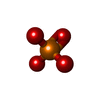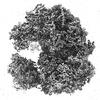+Search query
-Structure paper
| Title | Insights into translocation mechanism and ribosome evolution from cryo-EM structures of translocation intermediates of Giardia intestinalis. |
|---|---|
| Journal, issue, pages | Nucleic Acids Res, Vol. 51, Issue 7, Page 3436-3451, Year 2023 |
| Publish date | Apr 24, 2023 |
 Authors Authors | Soneya Majumdar / Andrew Emmerich / Sascha Krakovka / Chandra Sekhar Mandava / Staffan G Svärd / Suparna Sanyal /  |
| PubMed Abstract | Giardia intestinalis is a protozoan parasite that causes diarrhea in humans. Using single-particle cryo-electron microscopy, we have determined high-resolution structures of six naturally populated ...Giardia intestinalis is a protozoan parasite that causes diarrhea in humans. Using single-particle cryo-electron microscopy, we have determined high-resolution structures of six naturally populated translocation intermediates, from ribosomes isolated directly from actively growing Giardia cells. The highly compact and uniquely GC-rich Giardia ribosomes possess eukaryotic rRNAs and ribosomal proteins, but retain some bacterial features. The translocation intermediates, with naturally bound tRNAs and eukaryotic elongation factor 2 (eEF2), display characteristic ribosomal intersubunit rotation and small subunit's head swiveling-universal for translocation. In addition, we observe the eukaryote-specific 'subunit rolling' dynamics, albeit with limited features. Finally, the eEF2·GDP state features a uniquely positioned 'leaving phosphate (Pi)' that proposes hitherto unknown molecular events of Pi and eEF2 release from the ribosome at the final stage of translocation. In summary, our study elucidates the mechanism of translocation in the protists and illustrates evolution of the translation machinery from bacteria to eukaryotes from both the structural and mechanistic perspectives. |
 External links External links |  Nucleic Acids Res / Nucleic Acids Res /  PubMed:36912103 / PubMed:36912103 /  PubMed Central PubMed Central |
| Methods | EM (single particle) |
| Resolution | 3.25 - 6.49 Å |
| Structure data | EMDB-16211, PDB-8br8: EMDB-16222, PDB-8brm: EMDB-16225, PDB-8bsi: EMDB-16226, PDB-8bsj: EMDB-16228, PDB-8btd: EMDB-16235, PDB-8btr: |
| Chemicals |  ChemComp-PO4:  ChemComp-GDP: |
| Source |
|
 Keywords Keywords | RIBOSOME / Translation / Giardia / Eukaryote / Eukaryotic / Macromolecule / tRNA / EF-2 / Elongation / GDP |
 Movie
Movie Controller
Controller Structure viewers
Structure viewers About Yorodumi Papers
About Yorodumi Papers















 giardia lamblia atcc 50803 (eukaryote)
giardia lamblia atcc 50803 (eukaryote)